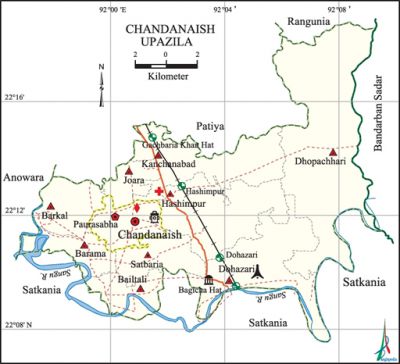Chandanaish Upazila
Chandanaish Upazila (chittagong district) area 201.72 sq km, located in between 22°02' and 22°08' north latitudes and in between 91°49' and 92°09' east longitudes. It is bounded by patiya and rangunia upazilas on the north, satkania upazila on the south, bandarban sadar and Satkania upazilas on the east, anowara upazila on the west.
Population Total 186840; male 95503, female 91337; Muslim 156797, Hindu 24695, Buddhist 142, Christian 5156 and others 50.
Water bodies Main river: sangu.
Administration Chandanaish Thana was formed in 1976 and it was turned into an upazila on 2 July 1983.
| Upazila | ||||||||
| Municipality | Union | Mouza | Village | Population | Density (per sq km) | Literacy rate (%) | ||
| Urban | Rural | Urban | Rural | |||||
|
1 |
9 |
41 |
55 |
11233 |
175607 |
926 |
66.0 |
54.3 |
| Upazila Town | ||||||||
|
Area |
Mouza |
Population |
Density |
Literacy rate | ||||
|
3.88 |
2 |
11233 |
2895 |
66.0 | ||||
| Union | ||||
| Name of union and GO code | Area (acre) | Population | Literacy rate (%) | |
| Male | Female | |||
|
Kanchanabad 85 |
5691 |
10191 |
8685 |
54.51 |
|
Joara 76 |
1653 |
6256 |
6426 |
61.52 |
|
Dohazari 47 |
8105 |
16685 |
15647 |
49.60 |
|
Dhopachhari 38 |
14277 |
3740 |
3503 |
30.41 |
|
Barkal 19 |
6257 |
8992 |
8606 |
61.08 |
|
Barama 28 |
2375 |
9391 |
9437 |
60.33 |
|
Bailtali 9 |
2359 |
9712 |
9311 |
56.73 |
|
Satbaria 95 |
2878 |
10933 |
11025 |
56.42 |
|
Hashimpur 66 |
6835 |
13904 |
13163 |
57.95 |
Source Bangladesh Population Census 2001,Bangladesh Bureau of Statistics.

Archaeological heritage and relics Three domed Khan Mosque (Bagicha Hat), Nabaratna Bihar (Satbaria), Buri Kali Mandir (Barama), Khan Dighi (Bagicha Hat).
Historical events The Mughal army conquered chittagong in 1666; later, the Mughal army crossed the karnafuli river and established their position at the northern bank of the Sangu River under Murtaza Khan. Adhu Khan and Lakshman Singh, two hazari mansabdars were deputed to defend the border of that area. It is assumed that Dohazari was named after these two hazari mansabdars. Later on, two forts were built there. The British built an air base at Dohazari. Towards the end of the war of liberation, fierce battle took place between the Pakistan army and the freedom fighters in which the Pakistan army was defeated. During the Liberation War the swadhin bangla betar kendra was transferred to Dohazari from Chittagong town.
Marks of the War of Liberation Mass killing site 2.
Religious institutions Mosque 275, temple 70, tomb 20, sacred place 1, kiyang 11. Noted religious institutions: Satbaria Shanti Bihar (monastery), Gachhbaria Sarbojanin Hari Mandir and Baruni Snan at Barumati Canal.
Literacy rate and educational institutions Average literacy 56.5%; male 60.6%, female 52.2%. Noted educational institutions: Gachhbaria Degree College, Satbaria College, Amanatsafa Badrunnesa Mahila College, Jamijuri Technical School and College, Barama Trahi Menaka High School (1925), Gachhbaria Nittananda Gaurichandra High School, Barkal SZ High School, Shuchia High School, Kanchannagar High School, Joara Senior Madrasa.
Newspapers and periodicals Barumati, Ajker Chandanaish, Chandanaish Darpan, Seidiner Chandanaish, Shankha Chil, Darpan.
Cultural organisations Library 9, club 20, press club 2, cinema hall 2, women organisation 1, stadium 1.
Main sources of income Agriculture 36.41%, non-agricultural labourer 3.75%, industry 0.60%, commerce 19.11%, transport and communication 3.98%, service 16%, construction 1.48%, religious service 0.38%, rent and remittance 3.32% and others 14.97%.
Ownership of agricultural land Landowner 48.10%, landless 51.90%; agricultural landowner: urban 53.32% and rural 47.78%.
Main crops Paddy, wheat, sugarcane, potato, chili, mustard, vegetables.
Extinct or nearly extinct crops Jute, flax,tea, water-melon, tobacco, sweet potato.
Main fruits Jackfruit, pineapple, guava, lemon.
Fisheries, dairies and poultries This upazila has a number of fisheries, dairies, poultries, hatcheries and artificial breeding centres.
Communication facilities Roads: pucca 91 km, semi-pucca 450 km, mud road 700 km. Railway Station 3 (Dohazari, Hashimpur, Gachhbaria Khan Hat).
Extinct or nearly extinct traditional transport Palanquin, bullock cart.
Noted manufactories Garments, cold storage, printing press, ice factory, welding factory, flour mill, rice mill, saw mill.
Cottage industries Weaving, goldsmith, potteries, blacksmith, wood work, bamboo work, bakery, tailoring.
Hats, bazars and fairs Hats and bazars are 14, fairs 2; Khodar Hat, Bagicha Hat, Gachhbaria Khan Hat, Dohazari Bazar, Maulavibazar and Baruni Mela are notable.
Main exports Railway slipper, furniture, milk, chicken, guava, lemon, pineapple, vegetables.
Access to electricity All the wards and unions of the upazila are under rural electrification net-work. However 48.30% of the dwelling households have access to electricity.
Natural resources White clay and different types of stone.
Sources of drinking water Tube-well 95.57%, tap 0.52%, pond 1.41% and others 2.50%. The presence of arsenic at an excessive level has been detected in 0.02% of the shallow tube well water of the upazila.
Sanitation 52.74% (urban 81.52% and rural 51%) of dwelling households of the upazila use sanitary latrines and 35.82% (urban 13.64% and rural 37.17%) of dwelling households use non-sanitary latrines; 11.44% of households do not have latrine facilities.
Health centres Hospital 1, upazila health complex 2, union health centre 5, family planning centre 10, community clinic 10.
NGO activities Operationally important NGOs are brac, asa, Uddipan, caritas, Palli Pragati Sangstha. [SM Abu Zaker]
References Bangladesh Population Census 2001, Bangladesh Bureau of Statistics; Cultural survey report of Chandanaish Upazila 2007.
